The Science & Creativity Behind the Perfect Mix
What really makes a cocktail? Mixology is an art that needs a deep understanding of bartending and a love for new recipes. It’s about finding the right mix of flavors and how they look. From old favorites to new ideas, mixology is all about balance and presentation.
⚠️ Alcohol Content Disclaimer: GetUrDrinkOn.com features content related to alcoholic beverages and mixology. All content is intended for informational and entertainment purposes only. We do not sell alcohol or promote underage or irresponsible drinking. This site is intended for adults aged—21 and over in the United States, and 18 and over in most other countries. Please drink responsibly. If you or someone you know is struggling with alcohol use, please seek professional help.
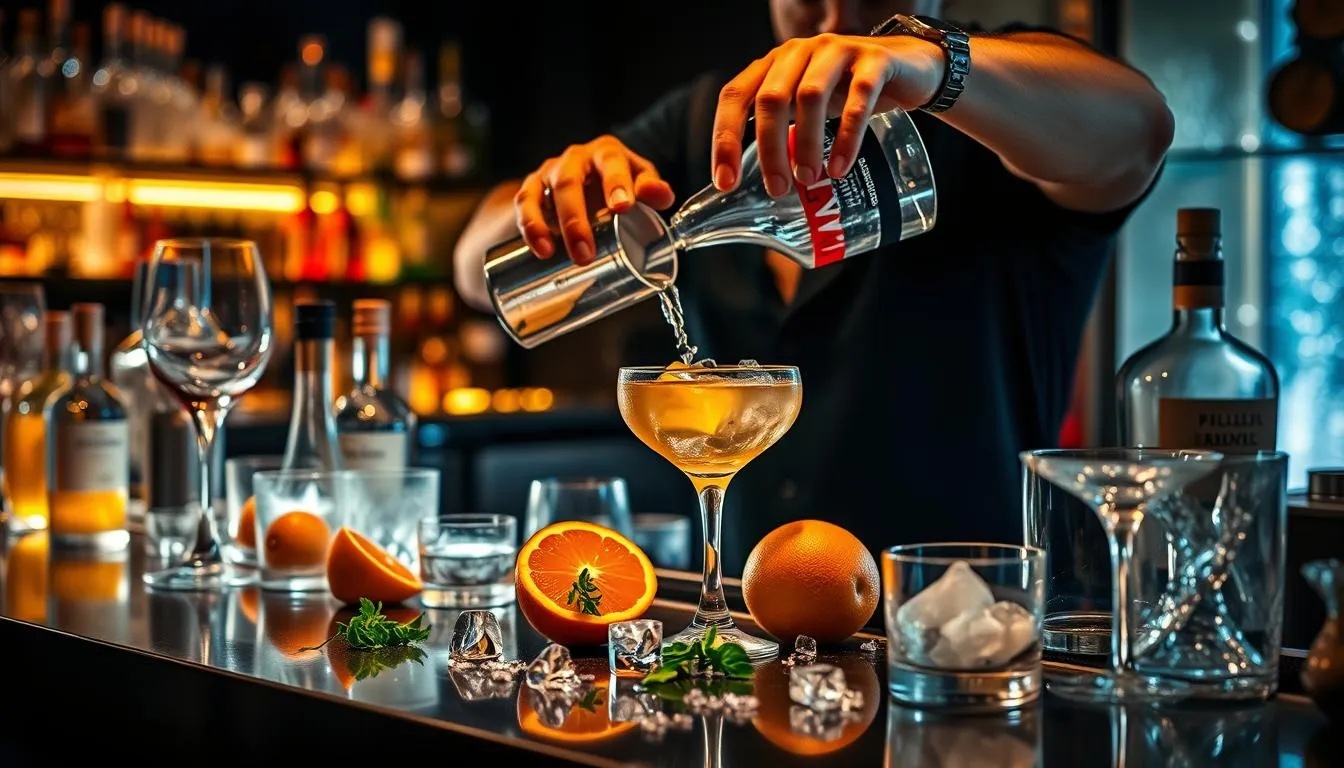
We’ll look into what makes a great cocktail. This includes balance, flavors, and how it looks. Whether you’re a pro or just starting, knowing the science and creativity is key to making amazing cocktails.
👉 If you love refreshing frozen drinks, slushies, creamy frappés, frozen margaritas, daiquiris, smoothies, and more the 🛒 Ninja FS301 Professional Maker with RapidChill Technology is a must-have addition to your kitchen or home bar!
The Art of Cocktail Creation
Mixology has a rich history and is always changing. It’s a field full of creativity and new ideas. By learning the basics and keeping up with trends, you can make cocktails that wow people.
Key Takeaways
- Understanding the science behind the perfect mix is essential for crafting great cocktails
- Balance and flavor profiles are key elements in defining a great cocktail
- Presentation and garnishing can make or break the overall cocktail experience
- Staying up-to-date on the latest mixology trends and techniques is crucial for creativity and innovation
- Mastering the fundamentals of bartending is essential for creating exceptional cocktail recipes
- Experimenting with unique ingredients and flavors can help you develop your own signature style
The Essential Definition of a Cocktail
When we talk about drink mixing, the word “cocktail” is often used in many ways. But what does it really mean? To grasp the true meaning of a cocktail, we must look into its cocktail history. We’ll see how it has changed over time, influenced by bar essentials and mixology.
A key part of cocktail history is knowing the difference between mixed drinks and cocktails. Both mix different ingredients, but cocktails have a special mix. They usually have a spirit, a sweetener, and a sour part. This mix of flavors and ingredients makes a cocktail a masterpiece.
- A balance of sweet, sour, and strong flavors
- The use of bar essentials such as mixers, garnishes, and glassware
- A focus on drink mixing techniques and presentation
Understanding these points helps us see the art and science in making a great cocktail.
The Four Fundamental Elements of Every Great Cocktail
Creating a great cocktail involves four key elements: base spirits, sweet, sour, and strong. These elements blend to form a flavor profile that makes a cocktail stand out. Bartenders must learn to balance and mix these elements to craft unique, tasty drinks.
Balance is crucial in making a great cocktail. It’s about finding harmony among the elements so none dominates. Bartenders who master balance can create drinks that are both refreshing and complex. This balance is key, whether using classic or new flavors.
Important mixology techniques include knowing how to mix sweet and sour flavors. Also, using base spirits as a foundation is vital. These skills help bartenders make a variety of tasty, visually appealing cocktails. With the right mix and understanding of flavor profiles and balance, the possibilities are endless.
Bartenders who focus on the four fundamental elements and balance can make memorable cocktails. Whether you’re experienced or new, grasping the importance of flavor profiles and balance is key. It’s essential for success in mixology.
Understanding Base Spirits: The Foundation of Cocktail Making
In cocktail making, the base spirit is the core. It gives the drink its main flavor and character. With many base spirits out there, like gin, vodka, rum, and whiskey, picking the right one can be tough.
There are several main types of base spirits. You have clear ones like vodka and gin, and darker ones like whiskey and rum. Each has its own taste and is best for certain cocktails. For instance, gin is great in a Martini, while whiskey is perfect for an Old Fashioned.
Types of Base Spirits and Their Uses
- Gin: often used in classic cocktails like the Martini and the Gin and Tonic
- Vodka: often used in cocktails like the Cosmopolitan and the Bloody Mary
- Rum: often used in tropical cocktails like the Daiquiri and the Mojito
- Whiskey: often used in classic cocktails like the Old Fashioned and the Manhattan
Knowing the different base spirits and their uses is crucial for cocktail making. The right base spirit can make your cocktails unique and tasty. Whether you’re an expert or new to liquor, understanding base spirits is essential for making great drinks.
The Art of Balance: Sweet, Sour, Strong, and Weak
In mixology, balance is key to a perfect flavor. A balanced cocktail has the right mix of sweet, sour, strong, and weak. This balance makes a great cocktail stand out.
Flavor profiles are crucial in mixology. A skilled mixologist can adjust these elements for a unique taste. For instance, adding lemon or lime juice can balance out sweetness. A strong spirit can be toned down with water or soda.
Here are some key elements to consider when achieving balance in mixology:
- Sweet: sugars, syrups, and sweet liqueurs
- Sour: citrus juices, such as lemon or lime
- Strong: spirits, such as gin or whiskey
- Weak: water, soda, or other low-alcohol ingredients
Understanding balance and adjusting sweet, sour, strong, and weak elements is vital. It lets you craft unique and tasty cocktails. Whether you’re a pro or just starting, mastering balance is essential for creating great-tasting drinks.
What Makes a Cocktail a Cocktail: The Scientific Perspective
Cocktail making is an art that uses molecular mixology and chemistry to create unique tastes. Mixing ingredients leads to chemical reactions that change the cocktail’s taste and look. Knowing these reactions is key for any mixologist.
Temperature and how much water is added are crucial in shaping a cocktail’s flavor. As ingredients mix, they change chemically, affecting the drink’s taste. Cocktail science helps us understand these changes, allowing us to make drinks that look good and taste great.
- Chemical reactions between ingredients
- Temperature and its impact on flavor
- Dilution and its effects on the drink’s character
Understanding these ideas lets mixologists explore new ways to make cocktails. They can create exciting, tasty drinks that please the senses.
Essential Tools and Techniques for Cocktail Creation
Creating cocktails requires the right tools and techniques. You need bartending tools like shakers and jiggers. Also, mixology techniques such as muddling and straining are crucial. Each tool and technique is important for making the perfect cocktail.
A good bar has many bartending tools. These include:
- Jiggers for measuring ingredients
- Shakers for mixing and chilling
- Muddlers for crushing fruits and herbs
- Strainers for filtering ice and solids
Knowing mixology techniques is also vital. It’s about balancing flavors, using the right ice, and garnishing. With the right tools and techniques, bartenders can make amazing cocktails.
👉 Check out the 🛒 Stanley Legendary Classic Pre-Party Flask, a durable and stylish flask designed for portability—great for outdoor events and casual gatherings.
Some key mixology techniques are:
- Muddling: crushing fruits and herbs to release their flavors and oils
- Shaking: mixing and chilling ingredients to create a smooth and creamy texture
- Straining: filtering ice and solids to create a clear and refined cocktail
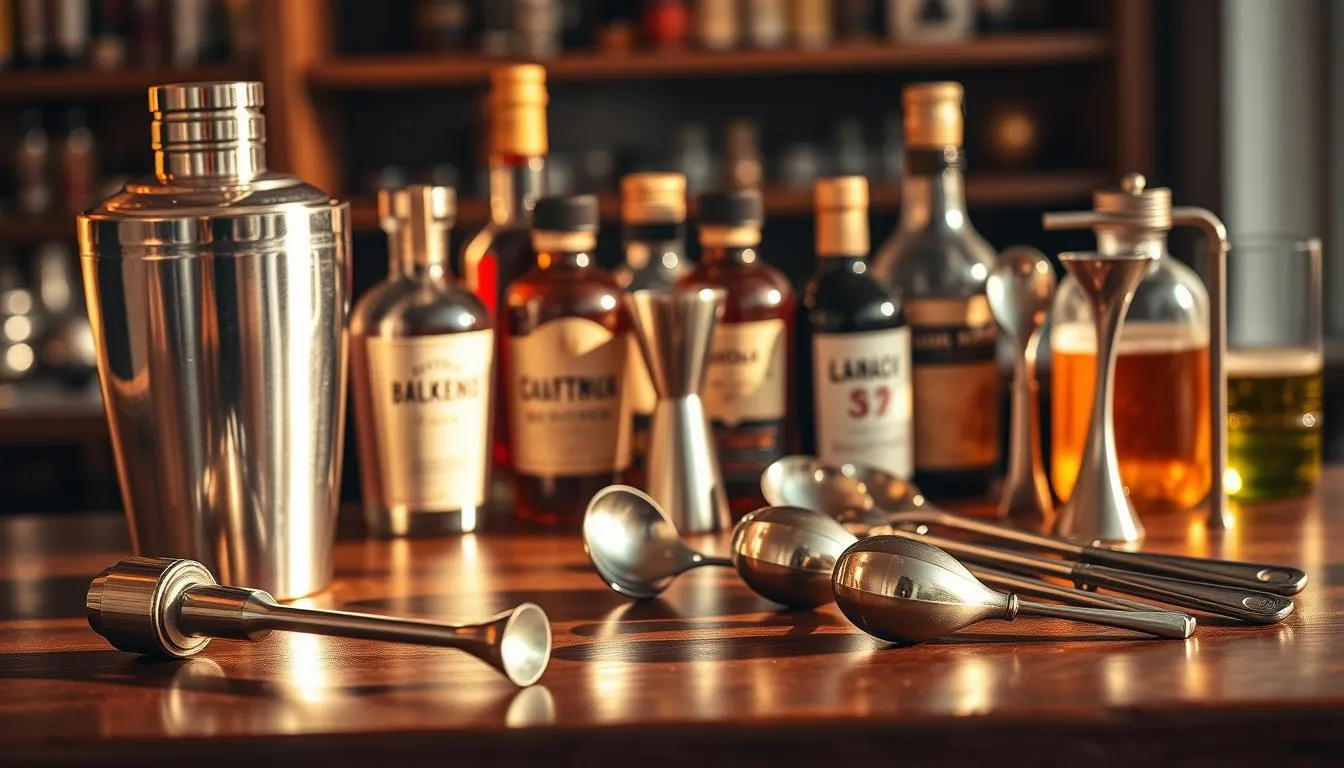
The Role of Modifiers and Enhancers
Cocktail ingredients fall into three main groups: base spirits, modifiers, and enhancers. Modifiers and enhancers are key in creating a cocktail’s flavor. They add depth and balance, making the drink more enjoyable.
Common modifiers and enhancers include bitters, liqueurs, and cordials. These add flavors like sweet, fruity, sour, and bitter. For instance, bitters bring a bitter taste, while liqueurs add sweetness. Fresh ingredients like citrus fruits and herbs also enhance flavors, adding a refreshing touch.
Here are some examples of modifiers and enhancers:
- Bitters: orange, angostura, and peach
- Liqueurs: triple sec, grand marnier, and cointreau
- Cordials: lemon, lime, and grapefruit
- Fresh ingredients: citrus fruits, herbs, and spices
It’s crucial to balance the flavors of modifiers and enhancers with the base spirits. A great cocktail has a mix of sweet, sour, strong, and weak tastes. By trying different combinations, you can craft unique and tasty cocktails that show off your mixology skills.
Understanding Cocktail Families and Classifications
Cocktail families and classifications are key in mixology. They help bartenders and fans know the different cocktails, their ingredients, and how to make them. Knowing these categories lets you create your own cocktails and enjoy mixology.
There are many cocktail families, like classics, moderns, fizzes, and sours. Each family has its own spirit, flavor, and mixing style. For instance, the Old Fashioned uses bourbon, sugar, and bitters. The Penicillin, on the other hand, has Scotch, honey-ginger syrup, and lemon juice.
Here are some important classifications to know:
- Sours: cocktails with a spirit, citrus juice, and sugar
- Fizzes: cocktails with a spirit, citrus juice, and soda water
- Classics: traditional cocktails with a spirit, sugar, and bitters
- Moderns: new cocktails with unique ingredients and methods
Knowing cocktail families and classifications is vital for making tasty cocktails. By trying different ingredients and methods, you can find your own style. Whether you’re a pro bartender or just starting, exploring cocktails is a fun journey of creativity and learning.
The Psychology of Cocktail Presentation
Creating an unforgettable cocktail experience starts with presentation. A well-presented cocktail can make it more enjoyable. The art of garnishing adds elegance and sophistication. Choosing the right glassware also enhances the drink’s look and taste.
A great cocktail presentation is a feast for the eyes. It should balance colors, textures, and shapes. A beautifully garnished cocktail in a stylish glass leaves a lasting impression. Fresh fruits, herbs, and edible flowers are popular garnishes for their color and fragrance.
Here are some tips for stunning cocktail presentation:
- Choose the right glassware for your cocktail, taking into account the shape, size, and material of the glass.
- Experiment with different garnishing techniques, such as twisting, slicing, or muddling, to add a unique touch to your cocktail.
- Consider the presentation of your cocktail, thinking about the colors, textures, and shapes that will complement the drink.
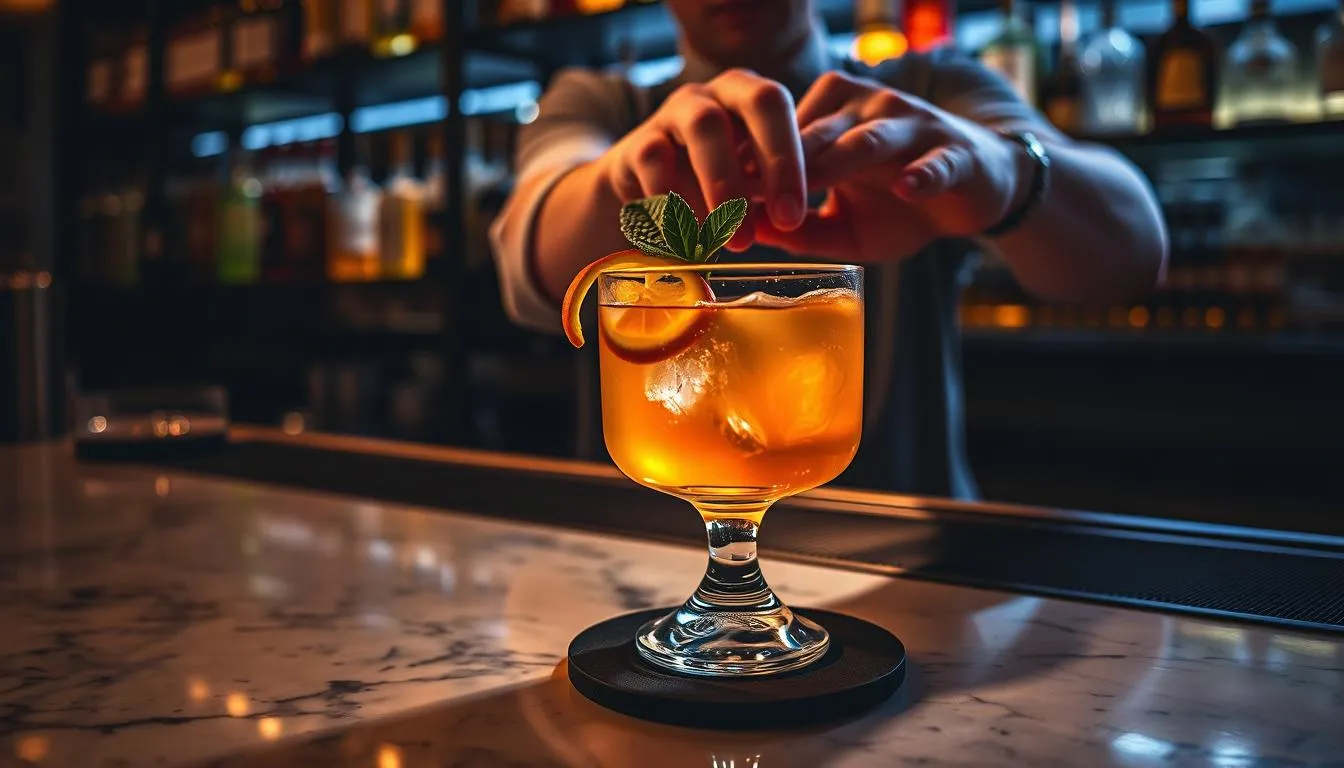
In conclusion, the psychology of cocktail presentation is complex. It involves garnishing, glassware, and overall presentation. By focusing on these details, bartenders can create unforgettable experiences that impress the drinker.
| Cocktail | Garnish | Glassware |
|---|---|---|
| Margarita | Salt rim, lime wheel | Rocks glass |
| Old Fashioned | Orange peel, cherry | Rocks glass |
| Martini | Olives, lemon twist | Cocktail glass |
Creative Expression in Modern Mixology
Modern mixology is now an art form, with a big focus on creative expression. Bartenders are viewed as artists, making unique and tasty cocktails. They use their skills and imagination, thanks to cocktail trends that keep changing.
In modern mixology, trying new things is key. Bartenders use experimental techniques like molecular mixology and fermentation. These methods let them be creative and flexible, leading to new cocktail trends.
Signature Drink Development
Creating signature drinks is a big part of modern mixology. These unique cocktails show off a bartender’s skills and style. They are a way for bartenders to share their personality and flair.
Some popular cocktail trends include using unusual ingredients like vegetables and herbs. Bartenders also aim to create complex flavors. These trends show the desire for creativity and innovation in cocktails.
- Use of unusual ingredients
- Creation of complex flavor profiles
- Experimentation with new techniques and methods
Modern mixology is a lively field, all about creative expression and innovation. By following cocktail trends and trying new things, bartenders make unique and tasty cocktails. These showcase their skills and style.
Building Your Cocktail-Making Foundation
To become a skilled mixologist, you need a solid foundation in cocktail making. You must understand the basics of mixology. This includes knowing the key elements of a great cocktail and how to make them.
Mastering these basics lets you try new recipes and find your own style. A well-stocked home bar is key for cocktail making. It should have various base spirits, mixers, and garnishes, along with the right tools and equipment.
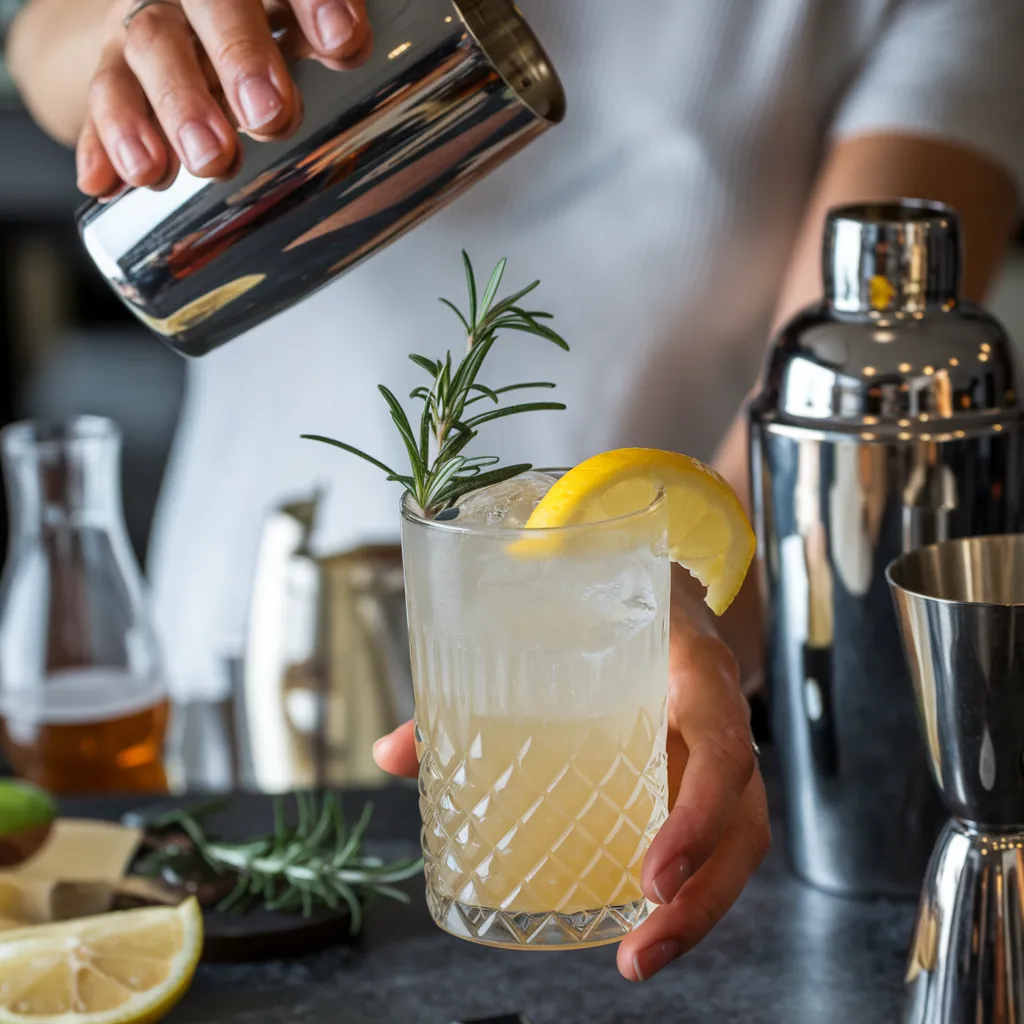
Some must-haves for your home bar are:
- Base spirits like gin, vodka, and rum
- Mixers such as tonic water and juice
- Garnishes like lemons, limes, and olives
- Tools like jiggers, muddlers, and shakers
Practice and trying new things are crucial for improving your mixology skills. Don’t worry if your first attempts don’t work out. With time and patience, you’ll get better and make amazing cocktails.
By focusing on cocktail making and mixology, you’re on your way to becoming a great mixologist. Keep practicing, experimenting, and learning. Soon, you’ll be making incredible cocktails for your friends and family.
👉 Upgrade your home whiskey setup with the sleek and functional 🛒 Zarler Bar Cart Bar Table with LED lighting, power outlet, and 4-tier liquor storage—perfect for any modern home bar.
Final Sip: Mastering the Art and Science of Cocktail Creation
Making the perfect cocktail is a mix of art and science. It starts with knowing the basics and then trying new things. Whether you’re a pro bartender or just starting, mastering mixology is exciting and rewarding.
As you keep learning, stay curious and eager to try new things. Don’t be afraid to mix up old recipes and add your own twist. Every drink you make is a chance to show off your skills and learn more about the science behind cocktails.
So, here’s to the fun and discovery that awaits you in the world of cocktails. Cheers to your ongoing journey in making drinks and the joy it brings.
Discover your drinking habits and impress your family and friends with this mockito Virgin Piña Colada
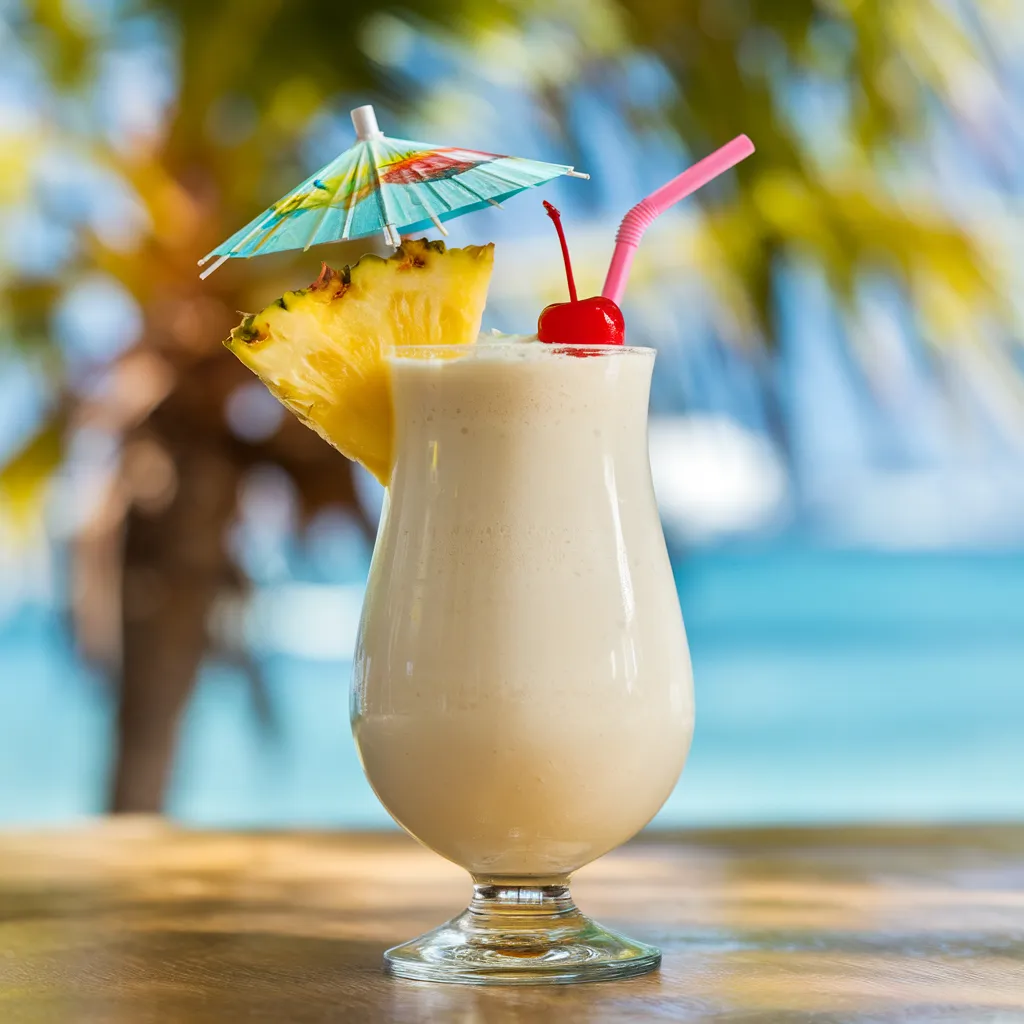
Join the Conversation!
Drop your thoughts in the comments below and let’s chat about all things beverage!
Frequently Asked Questions (FAQ)
The term “cocktail” started in the early 19th century. Its exact origin is still debated. Many think it was named for a specific drink with a spirit, sugar, water, and bitters.
Cocktails are more complex than mixed drinks. They mix spirits, sweeteners, citrus, and other ingredients well. Mixed drinks are simpler, often just a spirit and a mixer.
A great cocktail has four key parts: base spirits, sweet, sour, and strong. Mixing these elements right creates a balanced flavor.
The base spirit sets the flavor of a cocktail. Spirits like gin, vodka, rum, or whiskey change the taste and smell of a drink.
Balance is key in making a great cocktail. Mixing sweet, sour, strong, and weak elements right makes a drink that’s just right.
Temperature and dilution are important for a cocktail’s flavor. Chilling and dilution can change how flavors come through. Mixologists need to know this to make the perfect drink.
To make cocktails, you need basic tools like shakers, jiggers, and strainers. Knowing how to mix, stir, and shake is also important for making good drinks.
Bitters, liqueurs, and fresh ingredients add depth and unique flavors to cocktails. Skilled mixologists use these to make drinks that stand out.
Cocktails are grouped into families like classics and moderns. Knowing these styles helps mixologists create menus that are well-rounded.
How a cocktail is presented, from the glass to the garnish, affects the experience. Mixologists use this to make drinks that are not just tasty but also beautiful.
Modern mixology is always changing, with bartenders trying new things. They use unusual ingredients and techniques like molecular gastronomy to create exciting drinks.
To start making cocktails at home, learn the basics of mixology. Stock a good home bar and practice often. Being open to trying new things is key to improving your skills.



